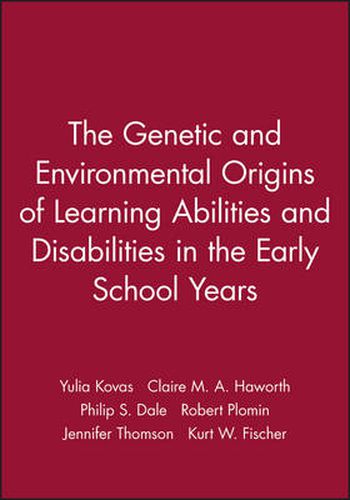Readings Newsletter
Become a Readings Member to make your shopping experience even easier.
Sign in or sign up for free!
You’re not far away from qualifying for FREE standard shipping within Australia
You’ve qualified for FREE standard shipping within Australia
The cart is loading…






Despite the importance of learning abilities and disabilities in education and child development, little is known about their genetic and environmental origins in the early school years. We report results for English (which includes reading, writing, and speaking), mathematics, and science as well as general cognitive ability in a large and representative sample of U.K. twins studied at 7, 9, and 10 years of age. Although preliminary reports of some of these data have been published, the purpose of this monograph is to present new univariate, multivariate, and longitudinal analyses that systematically examine genetic and environmental influences for the entire sample at all ages for all measures for both the low extremes (disabilities) and the entire sample (abilities). English, mathematics, and science yielded similarly high heritabilities and modest shared environmental influences at 7, 9, and 10 years despite major changes in content across these years. We draw three conclusions that go beyond estimating heritability. First, the abnormal is normal: low performance is the quantitative extreme of the same genetic and environmental influences operate throughout the normal distribution. Second, continuity is genetic and change is environmental: longitudinal analyses suggest that age-to-age stability is primarily mediated genetically whereas the environment contributes to change from age to age. Third, genes are generalists and environments are specialists: multivariate analyses indicate that genes largely contribute to similarity in performance within and between the three domains - and with general cognitive ability - whereas the environment contributes to differences in performance. These conclusions have far-reaching implications for education and child development as well as for molecular genetics and neuroscience.
$9.00 standard shipping within Australia
FREE standard shipping within Australia for orders over $100.00
Express & International shipping calculated at checkout
Despite the importance of learning abilities and disabilities in education and child development, little is known about their genetic and environmental origins in the early school years. We report results for English (which includes reading, writing, and speaking), mathematics, and science as well as general cognitive ability in a large and representative sample of U.K. twins studied at 7, 9, and 10 years of age. Although preliminary reports of some of these data have been published, the purpose of this monograph is to present new univariate, multivariate, and longitudinal analyses that systematically examine genetic and environmental influences for the entire sample at all ages for all measures for both the low extremes (disabilities) and the entire sample (abilities). English, mathematics, and science yielded similarly high heritabilities and modest shared environmental influences at 7, 9, and 10 years despite major changes in content across these years. We draw three conclusions that go beyond estimating heritability. First, the abnormal is normal: low performance is the quantitative extreme of the same genetic and environmental influences operate throughout the normal distribution. Second, continuity is genetic and change is environmental: longitudinal analyses suggest that age-to-age stability is primarily mediated genetically whereas the environment contributes to change from age to age. Third, genes are generalists and environments are specialists: multivariate analyses indicate that genes largely contribute to similarity in performance within and between the three domains - and with general cognitive ability - whereas the environment contributes to differences in performance. These conclusions have far-reaching implications for education and child development as well as for molecular genetics and neuroscience.